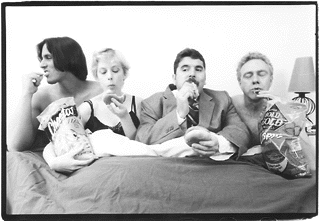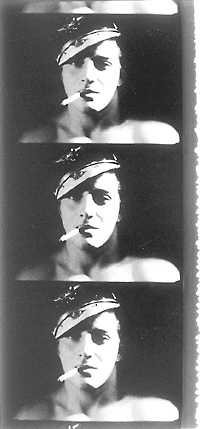Exhibitionism
The Food Chain: Great Taste, Less Filling
Fri., March 20, 1998
through March 28
Running Time: 2 hrs, 15 min

Playwright Nicky Silver has an incredible knack for exploding the small faults we all have and using these magnified idiosyncrasies to craft a play full of larger-than-life characters who can't get their personal shit together. Not surprising really, when you consider that the smallest, protective foible is stuck under Silver's glass and a pinpoint of light is focused on it until the poor, innocent foible pops under the gaze. A man who eats to forget becomes a 300-pound well of emotional need. A man who protects himself with vanity becomes a sexual machine, convinced that all the world wants him. And a woman who hides behind a wall of intellectualism ties herself to a man who never speaks. It's no wonder that they all simply vibrate with frustration, rapidly moving to the edge of explosion in the playwright's The Food Chain, produced here by the Subterranean Theatre Company.
These are the kind of characters, however, that are a thrill to play. Characters on the verge of hysteria, with readily identifiable drives and dreams, make for heightened behavior that is fun simply for its outrageousness, like the substantial kick Heather Locklear must have gotten playing Amanda, back when she was Melrose Place's queen bitch. It's fun to go over the top, especially when the playwright gives you such histrionic characters. And it makes for a hysterical evening of theatre, full of giant situational jokes that are like verbal slapstick.
You can see a wild gleam of unrestrainable joy in the eyes of this Subterranean cast. Douglas Taylor is perfect as the food-obsessed Otto, hopelessly in whiny love with Blake Yelavich's well-endowed Serge. Yelavich flavors Serge with more than bare-chested narcissism, giving his character an added layer of vulnerability that leaks through the glamorous facade. Lana Dieterich is a stitch as the not-so-helpful helpline staffer Bea, thwacking each line into the audience with sarcastic force. Katherine Catmull works as the frantic Amanda, a woman definitely on the verge of some kind of breakdown, and David Jones, as her husband Ford, makes the most of hang-dog looks and meaningful expressions.
While most of the show is a yuk-fest, this production of The Food Chain also seems to be lacking any real substance, like a meal of nothing but lemon curd and sweet tarts. Sure, it's fun for a while, but eventually you want a sliver of protein to justify all the bittersweet comedy. Unfortunately, neither Silver's script nor Ken Webster's direction strips away enoughof the characters' blown-up personas to deliver even the smallest speck of honest flesh, which, two hours after you've walked out of the theatre and digested all of the transient jokes, makes you almost forget that you've eaten at all. -- Adrienne Martini
THE BARBER OF SEVILLE: FOLLOW THE BOUNCING BARBER
Bass Concert Hall,
March 13
The overture starts, and we begin to bounce. From the instant our ears catch the opening strains of Rossini's familiar music -- that frisky, nimble romp up, down, and around the scale -- we're rising and falling with it, sailing skyward, zooming to earth, caroming off this wall and that, bob-bob-bobbing along. The score is a bright orange ball of lively rubber, an object of fun, and it carries us with it as it's put into play.
Now, you don't expect a rubber ball to keep bouncing forever; its energy will naturally dissipate and it will eventually dribble to a stop. But this particular ball of Rossini's as handled last week by Austin Lyric Opera never stopped bouncing until the final curtain fell, and even then it was as sprightly and springy as when the first notes had sounded. What seemed to keep it going was ALO's recognition that playfulness is at the heart of this work and one needs to play with it for it to come fully alive. Throughout, the music and singing and action were as animated and merry as if they were coming from kids in an oversized sandbox.
And how fitting, for the opera's characters might as well be overgrown kids given their eagerness for elaborate games of make-believe. Lovesick Almaviva dons not one but two preposterous disguises to gain entry to the house of his lady love, Rosina, who sees him only by sneaking around behind her guardian's back, like a disobedient schoolgirl. The barber Figaro arranges their assignations through schemes of subterfuge worthy of a hyper-imaginative sixth-grader. Even the sophisticated Dons Bartolo and Basilio take boyish delight in their shot at duplicitous gameplaying. The opera's contrivances are a frolic through a schoolyard, childhood games revisited.
Stage director Christopher Mattaliano sure did his bit to infuse the show with a sportive spirit -- or more precisely, he sure did infuse the show with bits. This show was a veritable Schtick City, with time-honored comic gems from pratfalls to takes to slow burns to sneezes punctuating every scene. Such bits require a light touch and comedic skill, but Mattaliano's actors tossed them off with the ease of old vaudevillians. And they looked to be having the time of their lives. As Figaro, David Malis burst on the scene and began attacking the opera's best-known aria with the gusto of an accomplished trickster. Robust and rounded in bright orange duds, he looked as if he ought to have "Sun-Kist" stamped on his backside. Mark Thomsen's Almaviva appeared at first a rather subdued suitor, but he turned up the wattage once his count took to his disguises. As a drunkard soldier, he roared and reeled from one side of the stage to the other; then, as a mannered and mannerly music teacher, he intoned pinched salutations that would drive a man mad. Steven Condy's Don Bartolo certainly looked close to madness; he gave us a masterful portrait of the frustrated dupe, the man who suspects a scheme but can't prove it and grows progressively more irritable and irate. With his full form clad in a mustard-hued coat, Condy was an old kettle coming steadily to boil. For sheer playfulness, however, no one could match Deidra Palmour; her Rosina was a showgirl, making every expression, every reaction its own show. Rolling her eyes, cooing, flirting, smirking, pouting, Palmour gave them all an adolescent fervor, and they provoked giddy glee. And filling in the edges were more comedic pleasures: Ed Russell's deadpan Dr. Basilio, Susan Nicely's put-upon (and allergy-plagued) maid Berta, Paul Norton's ridiculously gnarled old servant Ambrogio, and a corps of stilted, dancing policemen. All fun.
But it all began and ended with the music, which was treated just as playfully by conductor Cal Stewart Kellogg and his skilled orchestra. Kellogg drove the players with his now customary vigor, but kept their performance souffle light, skittering through the score. His work kept the ball lively for three hours that night and has kept it bouncing in my head in all the happy days since. -- Robert Faires
STILLS FROM FILMS BY KENNETH ANGER: ROOMFUL OF TROUBLEMAKERS
 Pro-Jex Gallery,
Pro-Jex Gallery,
through April 9
Kenneth Anger is, in a word, complex. The filmmaker's extended list of productions is as varied and bizarre as the credits of his long life: childhood dance partner of Shirley Temple, inspiration for the Rolling Stones' "Sympathy for the Devil," writer of the Seventies bestseller Hollywood Babylon, and, most notably, major innovator of avant-garde filmmaking.
Which brings us this exhibit, a collection of stills from some of Anger's most memorable cult classics, movies hard to find but well-known among film buffs and connoisseurs. The bulk of these photos come from Scorpio Rising, Inauguration of the Pleasure Dome, and Invocation of My Demon Brother, three works from the Sixties in which Anger employed his then-daring and unconventional lighting and sound techniques. These techniques, along with the films' inherently disturbing subject matter, earned Anger the reputation as a truly anomalous filmmaker, one whose influence would eventually be evident in such latter-day risk takers as Martin Scorsese and David Lynch.
The photos themselves look amazingly contemporary, both in their quality and the innately modern feel of the lighting and colors. Hanging together in Pro-Jex's compact space, the pieces present a roomful of troublemakers, people with more than a little glint of rebellion in their eyes. The carnival of eccentrics includes Anäis Nin's caged head in Anäis Nin as Astarte, a motley crew of studded leather jacket-wearing thugs -- with transparent images of Satan floating over them -- in Bobby Beausoleil as the Demon, the creepiest of clowns in Rabbit's Moon, and a shirtless Elvis-meets-James Dean in Victor Childe as Biker. These brooding characters occupy a world of pure Anger: dark, shadowy, and mysterious.
Of course, Kenneth Anger's work is difficult to comprehend via still photography; the photos obviously cannot convey Anger's signature use of sound and movement or that Anger-esque neurotic energy for which he is so well-known. They do, however, afford a rare quiet peek at Anger's images, images highly resistant to sitting still in the films. This show holds great appeal for Anger fans and film junkies, as well as for folks who relish a glimpse of human nature's dark side.
Pro-Jex is also offering another rarity -- an opportunity to meet Anger himself -- at an opening for the show this Friday, March 20, in the gallery's new home in the ArtPlex, 1705 Guadalupe. -- Cari Marshall








